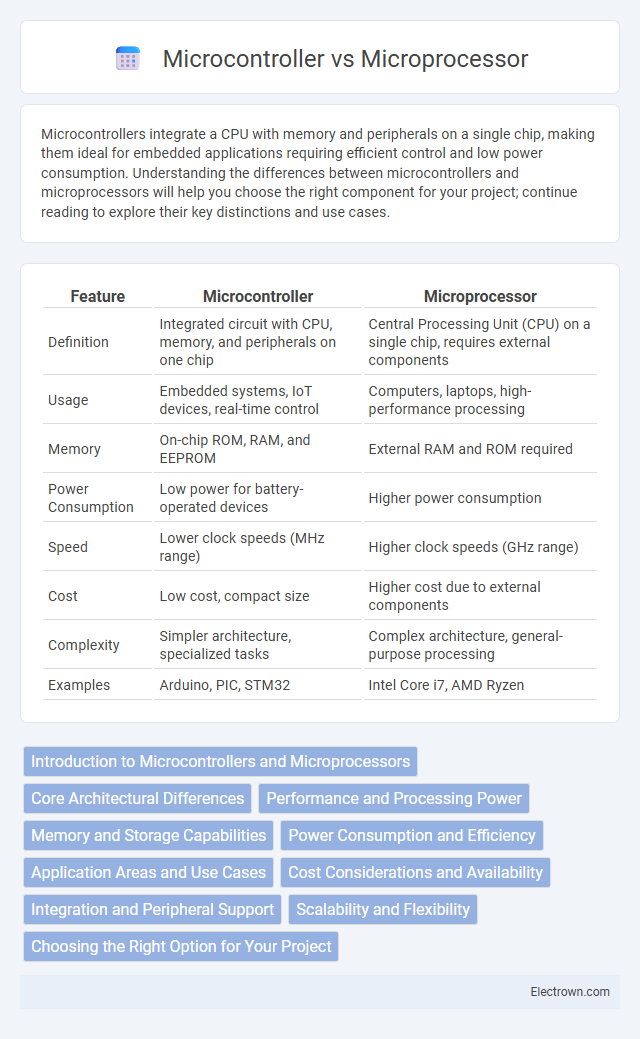Microcontrollers integrate a CPU with memory and peripherals on a single chip, making them ideal for embedded applications requiring efficient control and low power consumption. Understanding the differences between microcontrollers and microprocessors will help you choose the right component for your project; continue reading to explore their key distinctions and use cases.
Table of Comparison
| Feature | Microcontroller | Microprocessor |
|---|---|---|
| Definition | Integrated circuit with CPU, memory, and peripherals on one chip | Central Processing Unit (CPU) on a single chip, requires external components |
| Usage | Embedded systems, IoT devices, real-time control | Computers, laptops, high-performance processing |
| Memory | On-chip ROM, RAM, and EEPROM | External RAM and ROM required |
| Power Consumption | Low power for battery-operated devices | Higher power consumption |
| Speed | Lower clock speeds (MHz range) | Higher clock speeds (GHz range) |
| Cost | Low cost, compact size | Higher cost due to external components |
| Complexity | Simpler architecture, specialized tasks | Complex architecture, general-purpose processing |
| Examples | Arduino, PIC, STM32 | Intel Core i7, AMD Ryzen |
Introduction to Microcontrollers and Microprocessors
Microcontrollers integrate a CPU, memory, and input/output peripherals into a single chip, enabling compact and cost-effective embedded system applications. Microprocessors consist primarily of a CPU and require external components like RAM and ROM for operation, resulting in more flexible and powerful computing capabilities suitable for complex tasks. The microcontroller's architecture supports real-time control systems, while microprocessors excel in general-purpose computing environments.
Core Architectural Differences
Microcontrollers integrate a CPU core, memory blocks (RAM, ROM), and peripherals on a single chip, making them ideal for embedded control applications with real-time constraints. Microprocessors rely on an external memory and peripheral components, providing higher processing power and flexibility for complex computing tasks. Understanding these core architectural differences helps you choose the right solution for system design, balancing integration and performance requirements.
Performance and Processing Power
Microprocessors typically offer higher performance and greater processing power due to their complex architecture and higher clock speeds, making them ideal for computationally intensive tasks. Microcontrollers integrate a CPU with memory and peripherals on a single chip, providing efficient, real-time control but with limited processing capabilities compared to microprocessors. Your choice depends on whether you need high-speed data processing or integrated control for embedded applications.
Memory and Storage Capabilities
Microcontrollers integrate on-chip memory including RAM, ROM, and flash, enabling compact and efficient storage designed for embedded applications. Microprocessors rely on external memory modules, offering flexible and larger storage capacity but increasing system complexity and overall size. Understanding your project's memory and storage requirements helps determine whether the integrated solution of a microcontroller or the expandable memory architecture of a microprocessor is more suitable.
Power Consumption and Efficiency
Microcontrollers consume significantly less power than microprocessors due to their integrated design, which combines CPU, memory, and peripherals on a single chip, optimizing energy efficiency for embedded applications. Microprocessors, designed for higher performance and complex tasks, require separate components and typically operate at higher clock speeds, resulting in greater power consumption. Your choice between the two depends on the balance you need between processing power and power efficiency for your specific project requirements.
Application Areas and Use Cases
Microcontrollers are commonly used in embedded systems such as automotive controls, home appliances, and IoT devices due to their integrated memory and peripherals, enabling real-time control and low power consumption. Microprocessors excel in complex computing tasks found in personal computers, servers, and high-performance applications that require extensive processing power and multitasking capabilities. The choice depends on the requirement for integration and control versus computational throughput and flexibility.
Cost Considerations and Availability
Microcontrollers typically offer lower cost and greater availability for embedded applications due to their integrated peripherals and simpler architecture. Microprocessors, while more expensive, provide higher processing power and flexibility but often require additional components, increasing overall system cost. Understanding your project's budget and component availability helps determine whether a microcontroller or microprocessor is the more cost-effective choice.
Integration and Peripheral Support
Microcontrollers integrate a CPU, RAM, ROM, and multiple peripherals like timers, ADCs, and communication interfaces on a single chip, enabling compact and efficient embedded system designs. Microprocessors typically rely on external components for memory and peripheral functions, requiring additional circuitry and increasing design complexity. The on-chip integration of peripherals in microcontrollers reduces power consumption and cost, making them ideal for specific control-oriented applications.
Scalability and Flexibility
Microcontrollers offer limited scalability due to their integrated components, making them ideal for dedicated, low-power applications with fixed functionality. Microprocessors provide greater flexibility and scalability, supporting complex operating systems and a wide range of peripherals, which makes them suitable for tasks requiring extensive processing power and adaptability. Your choice depends on whether you prioritize compact integration or expandable performance capabilities.
Choosing the Right Option for Your Project
Microcontrollers integrate a CPU, memory, and peripherals on a single chip, making them ideal for embedded systems with real-time control and low power requirements. Microprocessors offer higher processing power and flexibility, suited for complex computing tasks and applications requiring extensive operating systems. Choosing between them depends on project needs for processing speed, integration level, power consumption, and cost-effectiveness.
Microcontroller vs Microprocessor Infographic

 electrown.com
electrown.com